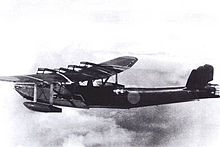Operation Stab
| Operation Stab | |||||||
|---|---|---|---|---|---|---|---|
| Part of thePacific Theatreof theSecond World War | |||||||
 | |||||||
| |||||||
| Belligerents | |||||||
|
|
| ||||||
| Commanders and leaders | |||||||
| James Somerville | Unknown | ||||||
| Units involved | |||||||
|
1 battleship 2 carriers 4 light cruisers 6 destroyers 1 minelayer 2 corvettes 2 sloops 1 aux vessel 2 tankers 10 transport ships | Unknown | ||||||
| Casualties and losses | |||||||
|
4 aircraft destroyed 4 killed (flying accidents) |
1 aircraft destroyed 9 killed | ||||||
Operation Stabwas a British naval deception during theSecond World Warto distract Japanese units for the forthcomingGuadalcanal campaignby the US armed forces.
Background
[edit]AdmiralErnest King,the head of theUS Navy,to provide a distraction for the forthcoming Guadalcanal Campaign. TheAdmiraltydiscussed the request with Vice-Admiral SirJames Somerville,the Commander-in-Chief of theEastern Fleet,stressing their apprehension at sending aircraft carriers into areas where they could be attacked by land-based aircraft.Operation Pedestal,a convoy operation to Malta, was due in early August, in which two aircraft carriers were to sail into range ofLuftwaffeandRegia Aeronauticaairfields and wanted to wait to discover their fate.[1]
The Admiralty view limited the scope of a diversion operation to air attacks onPort Blairin theAndaman IslandsorSabangin northern Sumatra. The Dutch naval commander, Vice-AdmiralConrad Helfrichsuggested that a raid on Sabang was pointless as the jungle made easy the dispersal and camouflage of aircraft. The main target in an attack on Port Blair would be the Japanese flying boats based there which needed a fighter attack but the relatively short range of these aircraft would mean that their aircraft carriers would be risking attack by land-based aircraft. A deception operation against the Andaman Islands, which had been captured by the Japanese in March 1942, was chosen instead.[1]
Plan
[edit]Convoys
[edit]
Three dummy convoys, Force V, consisting ofBlackheath,CranfieldandMahout,escorted byHMISJummaandHMSScoutwould sail fromVizagapatam.Force M, fromMadras,consisted ofTasmania,Hoperange,Clan McIver,Yuen SangandCustodianescorted by the fleet minelayerHMSManxman,the corvetteAsterand the auxiliary patrol vesselSonovati.Force T, fromTrincomalee,consisted of theRoyal Fleet AuxiliarytankersRFAAppleleafandRFABroomdalewith the freightersShenkingandMarit Mærskescorted by the sloopHMISHindustanand the corvetteHMSMarguerite.[2]The three convoys were to sail in daylight on 1 August and turn back to their ports during the night.[3]
Force A
[edit]Somerville was to sail to the east of the convoys with Force A, based atCeylon,consisting of the battleshipHMSWarspite,the aircraft carriersHMSIllustriousandFormidable,the light cruisersHMSBirmingham,Effingham,Mauritiusand the NetherlanderHNLMSJacob van Heemskerck,with the destroyersHMSInconstant,HMASNapier,Nizam,NormanandHNLMSVan Galen.[4]Wireless messages were to be used to make sure that the Japanese discovered the ship movements and then to suggest that the operation has been postponed due to an accident.[1]
Operation
[edit]
On 28 July the Dutch submarineHNLMSO 23,in theMalacca Strait,reported two Japanese heavy cruisers and four destroyers at 5° 32' N, 98° 50' E, moving up the west coast of Thailand. Force V, which had no air cover was cancelled. Somerville judged that the force was a raid on Allied ships in the north of the Bay of Bengal, following the rumours planted in India of preparations for an attack on the Andaman Islands. Force M and Force T sailed on 1 August. After the report byO 23,Force A had sailed from Colombo on 30 July, conducted air reconnaissance and found nothing.[5]
Force A was spotted by a Japanese flying boat at10:40 a.m.on 1 August and reports were picked up from Tokyo announcing the discovery. Late in the morning of 2 August another flying boat was shot down by a Martlet fighter fromFormidableat 9° 26' N, 83° 16' E. Force A returned to Trincomalee late on 2 August as some of the ships were due to participate in Operation Stream, Operation Line and Operation Jane in theBattle of Madagascar.A wireless deception was undertaken to pretend that Force A was in the Bay of Bengal until 18 August.[5]
Aftermath
[edit]Analysis
[edit]
While the operation was carried out without loss, the Japanese failed to take the bait and no significant naval or air units were redeployed – although the seaplane tenderSagara Maruwas sent to the islands on 4 August and a bomber unit was sent to reinforce Sabang, it could be said to have been a minor success.[6][7]
Casualties
[edit]Several Japanese aircraft were spotted and aKawanishi H6K(Mavis) was shot down at 9° 26' N, 83° 16' E by aMartletfromFormidable.[8]Two Martlets and twoFulmarswere lost to accidents and engine failure.[9][6]
Footnotes
[edit]- ^abcWWJ 1995,p. 23.
- ^Jordan 2006,pp. 197, 100, 105, 188, 116, 152, 142, 115, 13;Stephenson 2020,p. 152.
- ^WWJ 1995,pp. 23–24.
- ^Gill 1968,p. 126.
- ^abWWJ 1995,pp. 24–25.
- ^abBertke, Smith & Kindell 2014,pp. 487–488.
- ^"Japanese Auxiliary Seaplane Tenders".combinedfleet.Retrieved24 February2019.
- ^WWJ 1995,p. 25.
- ^"HMS Warspite, British battleship, WW2".naval-history.net.Retrieved23 February2019.
References
[edit]- Bertke, Donald A.; Smith, Gordon; Kindell, Don (2014).World War II Sea War: The Allies Halt the Axis Advance: Day-to-Day Naval Actions April 1942 through August 1942.Vol. VI. Dayton, OH: Bertke Publications.ISBN978-1-937470-05-0.
- Gill, George Hermon (1968). "Chapter 5 – Guadalcanal – Pacific Hinge–pin".Royal Australian Navy, 1942–1945(online scan).Australia in the War of 1939–1945. Series 2 – Navy. Vol. II. Canberra, ACT: Australian War Memorial. pp. 126–127.OCLC637329967.
- Jordan, Roger W. (2006) [1999].The World's Merchant Fleets 1939: The Particulars and Wartime Fates of 6,000 Ships(2nd ed.). London: Chatham/Lionel Leventhal.ISBN978-1-86176-293-1.
- Stephenson, Charles (2020).The Eastern Fleet and the Indian Ocean 1942–1945: The Fleet that had to Hide.Barnsley: Pen & Sword Military.ISBN978-1-526783-62-2.
- The Campaigns in the Solomons and New Guinea.War with Japan [Ministry of Defence (Navy)]. Vol. III. London: HMSO. 1995.ISBN0-11-772819-5.
Further reading
[edit]- Gray, Edwyn (1990).Operation Pacific.Annapolis, MD: Naval Institute Press. p. 137.ISBN978-1-55750-650-4– via Archive Foundation.
- Rohwer, Jürgen; Hümmelchen, Gerhard (2005) [1972].Chronology of the War at Sea, 1939–1945: The Naval History of World War Two(3rd rev. ed.). London: Chatham Publishing.ISBN1-86176-257-7.
- Roskill, S. W.(1956).The Period of Balance.History of the Second World WarUnited Kingdom Military Series: The War at Sea 1939–1945. Vol. II. London:HMSO.OCLC174453986– via Hyperwar Foundation.
